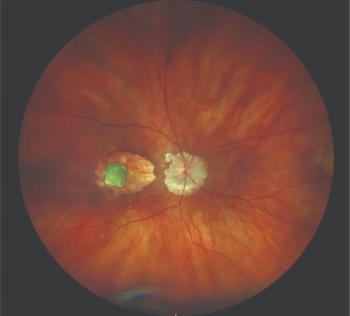
Drop, cyclosporine reduce discomfort
Both a non-preserved artificial tear containing carboxymethylcellulose 0.5% and cyclosporine ophthalmic emulsion 0.05% are viable options for minimizing dry eye-related discomfort post cataract surgery in "average patients."
Eau Claire, WI-Both a non-preserved artificial tear containing carboxymethylcellulose 0.5% (Refresh Plus, Allergan) and cyclosporine ophthalmic emulsion 0.05% (Restasis, Allergan) are viable options for minimizing dry eye-related discomfort post-cataract surgery in "average" patients, said Thomas M. Harvey, MD, a private practitioner, Chippewa Valley Eye Clinic, Eau Claire, WI.
Patient details
Patients were evaluated for dry eye disease at baseline and 1 and 2 months after surgery using a variety of subjective and objective measurements. In both groups, there was a statistically significant improvement in the Ocular Surface Disease Index (OSDI) at both postoperative visits. However, no other measures changed significantly from baseline in either group or comparing outcomes for the month 1 and month 2 postoperative visits, and there were no statistically significant differences between treatment groups at any visit in any of the endpoints assessed.
"Dry eye after cataract surgery is a real entity in the peer-reviewed literature with important clinical relevance because of its effects on patient comfort and vision," Dr. Harvey said.
"Its etiology is multifactorial," he added. "While very common, in part because the older patients undergoing cataract surgery represent a high-risk population, post-cataract surgery dry eye is an underappreciated condition. The results of this study show that among patients who have mild to moderate dry eye disease prior to cataract surgery, use of either [the non-preserved artificial tear] or cyclosporine allows maintenance of reasonable comfort after the procedure."
Results
Twenty-one patients completed all of the study visits. One patient in the cyclosporine group withdrew prematurely because of burning.
In addition to the OSDI, the subjective measures included patient ratings of drop comfort and vision. The objective assessments included measurement of tear break-up time (TBUT), fluorescein staining using the modified National Eye Institute grid, and topographic surface regularity analysis using the potential corneal acuity (PCA) function of a certain corneal topographer (Vista, EyeSys Vision).
Mean PCA values were 0.86 in both treatment groups preoperatively. At the 1- and 2-month follow-up visits, the mean PCA values were 0.84 and 0.87, respectively, in the artificial tears group and 0.76 and 0.74, respectively, in the cyclosporine group.
Mean TBUT was <8 seconds in both groups preoperatively. It decreased slightly after surgery in the cyclosporine group and was slightly better or unchanged at postoperative follow-up in the patients using the artificial tears.
"Unlike LASIK, the objective data indicate that topical cyclosporine is no better than a preservative-free artificial tear in the short term after cataract surgery," Dr. Harvey said. "This may be attributed to the longer use of corticosteroid drops after cataract surgery."
Preoperatively, the mean OSDI score was about 40 in the cyclosporine group and about 33 in the artificial tears group (possible range, 0 = normal, 100 = most severe). At 1 month after surgery, the mean OSDI score in both treatment groups was <10 and it decreased to <5 by 2 months.
FYI
Thomas M. Harvey, MD
E-mail:
Dr. Harvey acknowledged the collaboration of his co-author, Kristi Lambert, BS, research coordinator, Chippewa Valley Eye Clinic. Dr. Harvey is a member of the speaker's bureau for Allergan and Inspire Pharmaceuticals and is a paid consultant to ISTA Pharmaceuticals.
Newsletter
Don’t miss out—get Ophthalmology Times updates on the latest clinical advancements and expert interviews, straight to your inbox.





